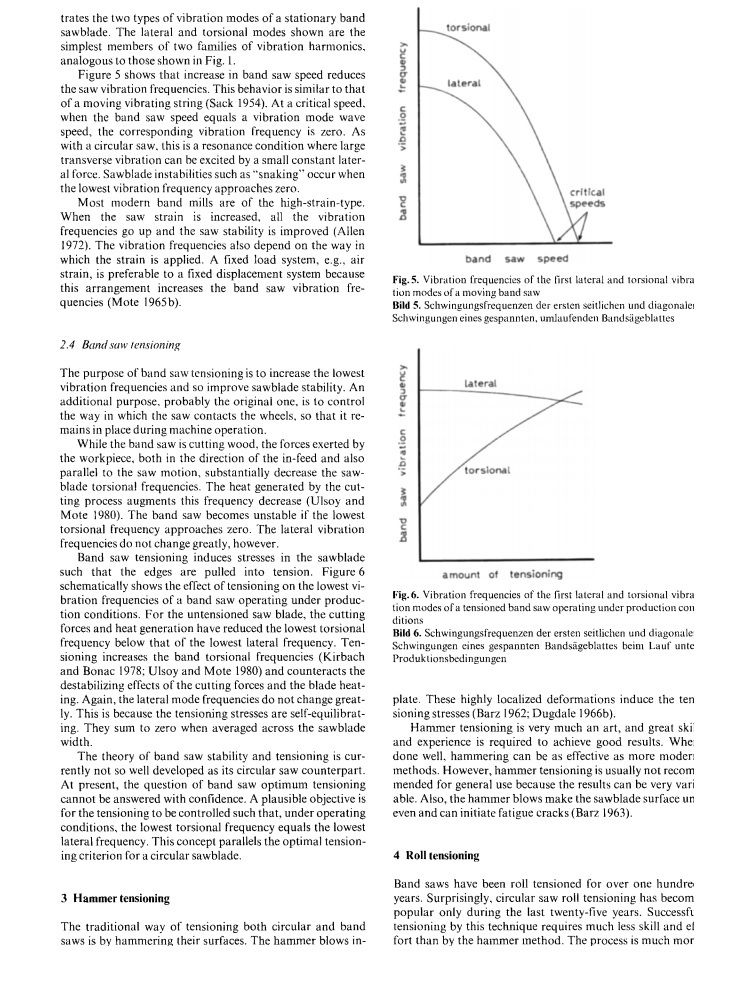Cheshirechappie
Established Member
Mike, you're right that the grain structure of steels is different depending on their heat-treatment condition (annealed, hardened right out, hardened and tempered back), but that won't affect their stiffness (or more technically, their elasticity below yield point). It will drastically affect their yield point and ultimate tensile strength, though.
Earlier in the thread, AndyT mentioned the book, "The New Science of Strong Materials" by J E Gordon. I'd heartily endorse his recommendation. For anybody wanting a deeper understanding of the metallurgy of steels (and other metals), a copy of "Engineering Metallurgy" volume I by R A Higgins should cure any insomnia, but also explain what's going on with grain structure when metals are worked or heat treated.
However, most saw doctoring is about the manipulation of internal stresses, not about grain size modification. Saw blades start out hardened and tempered, so the grain structure is pretty well set by that condition.
I'm a little bit wary of drawing comparisons between circular saws, band saws and hand saws. The reason is that both circular and band saws see stresses in service that handsaws don't.
A circular saw develops stresses in the plate as it spins, and the heat generated in cutting cause thermal expansion of the rim. It was found during the development of such saws during the early to mid 19th century that the detrimental effects those stresses could be alleviated by doctoring the saw before service - basically making it a flat cone or flat saucer shape instead of dead flat. The larger the saw, the more important the pre-service doctoring. The early texts such as 'Grimshaw on Saws' deal with this in some depth - many pages on circular saw doctoring, against a bare couple of pages on handsaws. It's interesting that vibration becomes a factor as rotational speeds increase, and that it's deleterious effects can be reduced by saw doctoring.
A band saw, when in service, IS under tension - that imparted by the top wheel adjustment mechanism. It will also see the load applied by the material being fed to it, and the balancing loads applied by the guide wheels to the back of the blade.
Handsaws see none of these loads - indeed, the stresses on a decently sharp hand, panel or backsaw are very low (you don't need to apply much force to get it to cut, just move it backwards and forwards). What stresses there are will be at the tooth-work interface, and mostly near the working bit of the tooth, the tip. The main body of the saw blade will see pretty well the same stresses it sees when lying on the bench. Thus, circular saw and bandsaw type 'tensioning' are not needed.
Maybe as the saw makers were wrestling with the problems of making reliable circular saws, they thought that the lessons they were learning could be applied to hand saws. I'm not at all sure that it actually does anything worthwhile to the hand saw blade, but it doesn't half sound good in the marketing blurb!
Earlier in the thread, AndyT mentioned the book, "The New Science of Strong Materials" by J E Gordon. I'd heartily endorse his recommendation. For anybody wanting a deeper understanding of the metallurgy of steels (and other metals), a copy of "Engineering Metallurgy" volume I by R A Higgins should cure any insomnia, but also explain what's going on with grain structure when metals are worked or heat treated.
However, most saw doctoring is about the manipulation of internal stresses, not about grain size modification. Saw blades start out hardened and tempered, so the grain structure is pretty well set by that condition.
I'm a little bit wary of drawing comparisons between circular saws, band saws and hand saws. The reason is that both circular and band saws see stresses in service that handsaws don't.
A circular saw develops stresses in the plate as it spins, and the heat generated in cutting cause thermal expansion of the rim. It was found during the development of such saws during the early to mid 19th century that the detrimental effects those stresses could be alleviated by doctoring the saw before service - basically making it a flat cone or flat saucer shape instead of dead flat. The larger the saw, the more important the pre-service doctoring. The early texts such as 'Grimshaw on Saws' deal with this in some depth - many pages on circular saw doctoring, against a bare couple of pages on handsaws. It's interesting that vibration becomes a factor as rotational speeds increase, and that it's deleterious effects can be reduced by saw doctoring.
A band saw, when in service, IS under tension - that imparted by the top wheel adjustment mechanism. It will also see the load applied by the material being fed to it, and the balancing loads applied by the guide wheels to the back of the blade.
Handsaws see none of these loads - indeed, the stresses on a decently sharp hand, panel or backsaw are very low (you don't need to apply much force to get it to cut, just move it backwards and forwards). What stresses there are will be at the tooth-work interface, and mostly near the working bit of the tooth, the tip. The main body of the saw blade will see pretty well the same stresses it sees when lying on the bench. Thus, circular saw and bandsaw type 'tensioning' are not needed.
Maybe as the saw makers were wrestling with the problems of making reliable circular saws, they thought that the lessons they were learning could be applied to hand saws. I'm not at all sure that it actually does anything worthwhile to the hand saw blade, but it doesn't half sound good in the marketing blurb!


































